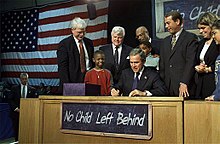 | |
| Long title | An act to close the achievement gap with accountability, flexibility, and choice, so that no child is left behind. |
|---|---|
| Acronyms (colloquial) | NCLB |
| Enacted by | the 107th United States Congress |
| Citations | |
| Public law | Pub. L. 107–110 (text) (PDF) |
| Statutes at Large | 115 Stat. 1425 |
| Codification | |
| Acts amended | List
|
| Titles amended | 15 U.S.C.: Commerce and Trade 20 U.S.C.: Education 42 U.S.C.: Public Health and Social Welfare 47 U.S.C.: Telegraphy |
| U.S.C. sections amended | 15 U.S.C. ch. 53, subch. I §§ 2601–2629 20 U.S.C. ch. 28 § 1001 et seq. 20 U.S.C. ch. 70 42 U.S.C. ch. 119 § 11301 et seq. 47 U.S.C. ch. 5, subch. VI § 609 47 U.S.C. ch. 5, subch. II § 251 et seq. 47 U.S.C. ch. 5, subch. I § 151 et seq. 47 U.S.C. ch. 5, subch. II § 271 et seq. |
| Legislative history | |
| |
| Major amendments | |
| Repealed on December 10, 2015. Replaced with Every Student Succeeds Act | |
| ||
|---|---|---|
|
Business and personal
46th Governor of Texas 43rd President of the United States
Tenure Presidential campaigns  |
||
| This article is part of a series on |
| Education in the United States |
|---|
| Summary |
| Curriculum topics |
| Education policy issues |
| Levels of education |
|
|

The No Child Left Behind Act of 2001 (NCLB)[1][2] was a 2002 U.S. Act of Congress promoted by the presidency of George W. Bush. It reauthorized the Elementary and Secondary Education Act and included Title I provisions applying to disadvantaged students.[3] It mandated standards-based education reform based on the premise that setting high standards and establishing measurable goals could improve individual outcomes in education. To receive federal school funding, states had to create and give assessments to all students at select grade levels.
The act did not set national achievement standards. Instead, each state developed its own standards.[4] NCLB expanded the federal role in public education through further emphasis on annual testing, annual academic progress, report cards, and teacher qualifications, as well as significant changes in funding.[3] While the bill faced challenges from both Democrats and Republicans, it passed in both chambers of the legislature with significant bipartisan support.[5]
Many provisions of the act generated significant controversy. By 2015, bipartisan criticism had increased so much that a bipartisan Congress stripped away the national features of No Child Left Behind. Its replacement, the Every Student Succeeds Act, turned the remnants over to the states.[6][7]
- ^ Pub. L. 107–110 (text) (PDF), 115 Stat. 1425, enacted January 8, 2002.
- ^ The Elementary and Secondary Education Act (The No Child Left Behind Act of 2004)
- ^ a b "No Child Left Behind: An Overview". Education Week. Retrieved July 16, 2015.
- ^ "No Child Left Behind". Sonoma County Office of Education. Archived from the original on April 6, 2012. Retrieved March 21, 2012.
- ^ "To close the achievement gap with accountability, flexibility, and choice, so that no child is left behind". Library of Congress. March 22, 2001. Retrieved August 23, 2016.
- ^ Layton, Lyndsey (December 11, 2015) "Obama signs new K–12 education law that ends No Child Left Behind". Washington Post
- ^ Hirschfeld Davis, Julie (December 10, 2015). "President Obama Signs Into Law a Rewrite of No Child Left Behind". The New York Times.

